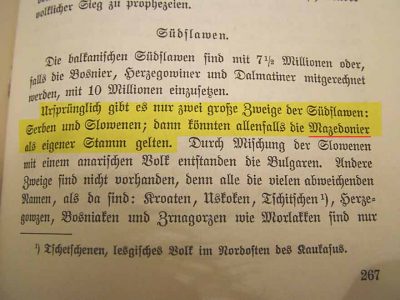Изворно има две главни гранки на јужнословенски народи, Србите и Словенците, потоа пред сѐ Македонците можат да бидат сметани како сопствена гранка. Како мешавина на Словенски и Аварски племиња создадени се Бугарите.
Originally there are two big branches of the south Slavic people, Serbians and Slovenians, then at most the Macedonians could be seen as a own branch. Through a mix between the Slovenians and an Avaric tribe, the Bulgarians were created.
Ursprünglich gibt es zwei große Zweige der Südslawen: Serben und Slowenen; dann könnten allenfalls die Mazedonier als eigener Stamm gelten. Durch Mischung der Slowenen mit einem awarischen Volk entstanden die Bulgaren.

Бугарите во Кралството се околу 3.2 милиони луѓе, заедно со Македонците 4 милиони луѓе.
The Bulgarians in the Kingdom are about 3.2 million people, together with the Macedonians 4 million people.
Die Bulgaren können im Königreich mit 3,2 Millionen angenommen werden, zusammen mit den Mazedoniern 4 Millionen.

Фелмераер, кој со духот наголемо го надмашувал своите опоненти, апсолутно е во право за една работа: дека веќе во 8ми век, цела Грција се до Кејп Матапан (најјужна копнена грчка точка) била населена со Словени и дека дури Спарта и падините на Тајгетос станале штабови на Словенските племиња. Истиот исто така ќе процени дека во негово време, околу 1840, таму имало некои области, вклучувајќи ја и самата Атика, каде Албанскиот бил подобро разбиран отколку Грчкиот.
Fallmerayer, who far surpassed his opponents in spirit, is absolutely right about one thing: that as early as the eighth century, all of Greece up to Cape Matapan was inhabited by Slavs and that even Sparta and the slopes of the Tajgetos became the headquarters of Slavic tribes. One will also assume that in his time, around 1840, there were some areas, namely Attica itself, where Albanian was understood better than Greek.
In einem hat Fallmerayer, der seine Gegner an Geist weit überragte, vollkommen recht: dass schon im achten Jahrhundert, ganz Griechenland bis zum Kap Matapan von Slawen bewohnt war und dass selbst Sparta und die Hänge des Tajgetos Hauptsitze slawischer Stämme wurden. Auch das wird man von ihm annehmen, dass es noch zu seiner Zeit, also um das Jahr 1840, so manche Gegenden gab, namentlich Attika selber, in denen Albanisch besser als Griechisch verstanden wurde.
Der Balkan. Seine Länder und Völker in Geschichte, Kultur, Politik, Volkswirtschaft, und Weltverkehr
Посочил: Macedonia History

